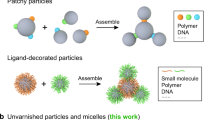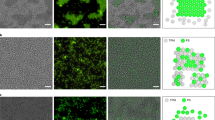Abstract
The assembly of complex structures out of simple colloidal building blocks is of practical interest for building materials with unique optical properties (for example photonic crystals1 and DNA biosensors2) and is of fundamental importance in improving our understanding of self-assembly processes occurring on molecular to macroscopic length scales3,4,5. Here we demonstrate a self-assembly principle that is capable of organizing a diverse set of colloidal particles into highly reproducible, rotationally symmetric arrangements. The structures are assembled using the magnetostatic interaction between effectively diamagnetic and paramagnetic particles within a magnetized ferrofluid. The resulting multipolar geometries resemble electrostatic charge configurations such as axial quadrupoles (‘Saturn rings’), axial octupoles (‘flowers’), linear quadrupoles (poles) and mixed multipole arrangements (‘two tone’), which represent just a few examples of the type of structure that can be built using this technique.
This is a preview of subscription content, access via your institution
Access options
Subscribe to this journal
Receive 51 print issues and online access
$199.00 per year
only $3.90 per issue
Buy this article
- Purchase on Springer Link
- Instant access to full article PDF
Prices may be subject to local taxes which are calculated during checkout




Similar content being viewed by others
References
Xia, Y. N., Gates, B. & Li, Z. Y. Self-assembly approaches to three-dimensional photonic crystals. Adv. Mater. 13, 409–413 (2001)
Elghanian, R., Storhoff, J. J., Mucic, R. C., Letsinger, R. L. & Mirkin, C. A. Selective colorimetric detection of polynucleotides based on the distance-dependent optical properties of gold nanoparticles. Science 277, 1078–1081 (1997)
Zerrouki, D., Baudry, J., Pine, D., Chaikin, P. & Bibette, J. Chiral colloidal clusters. Nature 455, 380–382 (2008)
Manoharan, V. N., Elsesser, M. T. & Pine, D. J. Dense packing and symmetry in small clusters of microspheres. Science 301, 483–487 (2003)
Whitesides, G. M. & Grzybowski, B. Self-assembly at all scales. Science 295, 2418–2421 (2002)
Dinsmore, A. D. et al. Colloidosomes: selectively permeable capsules composed of colloidal particles. Science 298, 1006–1009 (2002)
Velev, O. D., Lenhoff, A. M. & Kaler, E. W. A class of microstructured particles through colloidal crystallization. Science 287, 2240–2243 (2000)
Kim, S. H., Yi, G. R., Kim, K. H. & Yang, S. M. Photocurable Pickering emulsion for colloidal particles with structural complexity. Langmuir 24, 2365–2371 (2008)
Dreyfus, R. et al. Microscopic artificial swimmers. Nature 437, 862–865 (2005)
Musevic, I., Skarabot, M., Tkalec, U., Ravnik, M. & Zumer, S. Two-dimensional nematic colloidal crystals self-assembled by topological defects. Science 313, 954–958 (2006)
Biswal, S. L. & Gast, A. P. Rotational dynamics of semiflexible paramagnetic particle chains. Phys. Rev. E 69, 041406 (2004)
Yellen, B. B., Hovorka, O. & Friedman, G. Arranging matter by magnetic nanoparticle assemblers. Proc. Natl Acad. Sci. USA 102, 8860–8864 (2005)
Yin, Y., Lu, Y., Gates, B. & Xia, Y. Template-assisted self-assembly: A practical route to complex aggregates of monodispersed colloids with well-defined sizes, shapes, and structures. J. Am. Chem. Soc. 123, 8718–8729 (2001)
Shevchenko, E. V., Talapin, D. V., Kotov, N. A., O’Brien, S. & Murray, C. B. Structural diversity in binary nanoparticle superlattices. Nature 439, 55–59 (2006)
Leunissen, M. E. et al. Ionic colloidal crystals of oppositely charged particles. Nature 437, 235–240 (2005)
Ozin, G. A. & Yang, S. M. The race for the photonic chip: Colloidal crystal assembly in silicon wafers. Adv. Funct. Mater. 11, 95–104 (2001)
Zhuang, J., Wu, H., Yang, Y. & Cao, Y. C. Controlling colloidal superparticle growth through solvophobic interactions. Angew. Chem. Int. Ed. 47, 2208–2212 (2008)
Skjeltorp, A. T. One- and two-dimensional crystallization of magnetic holes. Phys. Rev. Lett. 51, 2306–2309 (1983)
Halsey, T. C. Electrorheological fluids. Science 258, 761–766 (1992)
Cho, Y. S. et al. Self-organization of bidisperse colloids in water droplets. J. Am. Chem. Soc. 127, 15968–15975 (2005)
Panofsky, W. K. H. & Phillips, M. Classical Electricity and Magnetism 84–86 (Addison Wesley, 1955)
Helgesen, G., Pieranski, P. & Skjeltorp, A. T. Dynamic behavior of simple magnetic hole systems. Phys. Rev. A 42, 7271–7280 (1990)
Erb, R. M. & Yellen, B. B. Concentration gradients in mixed magnetic and nonmagnetic colloidal suspensions. J. Appl. Phys. 103, 07A312 (2008)
Acknowledgements
The authors would like to thank the US National Science Foundation (grants NSEC DMI-0531171 and MRSEC DMR-0213695 to V.M.R. and grants CMMI-0608819 and CMMI-0625480 to B.B.Y.) for supporting this work.
Author information
Authors and Affiliations
Corresponding author
Supplementary information
Supplementary Information
This file contain Supplementary Materials and Methods, Supplementary Figures 1-3 with Legends and Supplementary Video Legends 1-5. (PDF 503 kb)
Supplementary Movie 1
This file shows the synchronous rotation of Saturn particles in a rotating external field (see files s1 for full legend). (MOV 866 kb)
Supplementary Movie 2
This file shows the formation and dissolution of Saturn particles (see file s1 for full legend). (MOV 4013 kb)
Supplementary Movie 3
This file shows a tri-component aqueous suspension of colloidal particles (see file s1 for full legend). (MOV 453 kb)
Supplementary Movie 4
This file shows the formation of mixed pole/ring structures (see file s1 for full legend). (MOV 1988 kb)
Supplementary Movie 5
This file shows flower shaped colloidal particles (see file s1 for full legend). (MOV 2813 kb)
Rights and permissions
About this article
Cite this article
Erb, R., Son, H., Samanta, B. et al. Magnetic assembly of colloidal superstructures with multipole symmetry. Nature 457, 999–1002 (2009). https://doi.org/10.1038/nature07766
Received:
Accepted:
Issue Date:
DOI: https://doi.org/10.1038/nature07766
This article is cited by
-
Synthesis of branched silica nanotrees using a nanodroplet sequential fusion strategy
Nature Synthesis (2023)
-
Acoustically manipulating internal structure of disk-in-sphere endoskeletal droplets
Nature Communications (2022)
-
Dual nature of magnetic nanoparticle dispersions enables control over short-range attraction and long-range repulsion interactions
Communications Chemistry (2022)
-
Total synthesis of colloidal matter
Nature Reviews Materials (2021)
-
Mattertronics for programmable manipulation and multiplex storage of pseudo-diamagnetic holes and label-free cells
Nature Communications (2021)
Comments
By submitting a comment you agree to abide by our Terms and Community Guidelines. If you find something abusive or that does not comply with our terms or guidelines please flag it as inappropriate.



